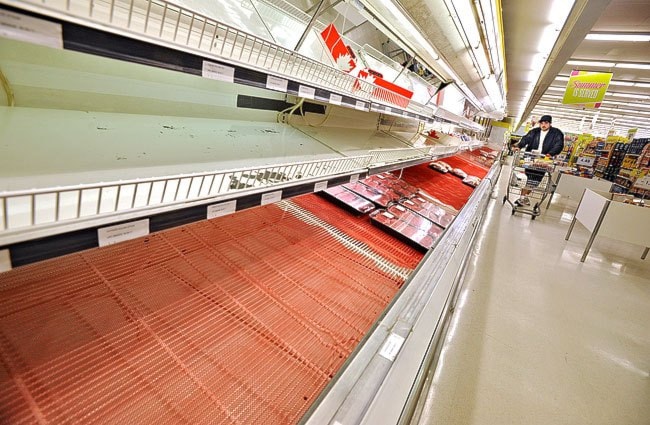Sarah “Drill Baby Drill” Palin would be proud of us! Our Alaskan friends may talk tough on oil and gas, but in reality they are a bunch of environmental wimps who do most of their drilling way up north out of sight of most Alaskans.
Our government, on the other hand, is talking about opening up thousands of square kilometres right around the capital city to drilling. Eye-balling the map in the paper, it looks like about half the shoreline of Lake Laberge is in scope. Not to mention an area the size of Luxembourg behind Kookatsoon Lake and another big chunk between my cabin at Tagish and Little Atlin Lake.
It brings up a potential solution to the Porter Creek D debate. If building houses is unacceptable to one side and leaving it undeveloped won’t work for another, how about a third option: drill rigs and a liquefied natural gas plant!
If only someone could figure out how to work a job-creating uranium slurry pipeline into the plan, it would be perfect!
Now that we’ve hyperventilated a bit, let’s have a look at the facts.
Firstly, although the blocks on the map are eye-catchingly big, we are currently at a very early stage in the process. To summarize a lot of very complicated government flowcharts, we are now at the stage where unknown industry players have expressed an interest in drilling in areas around Whitehorse and the government has decided to offer everyone a chance to bid.
Only in the future will we find out if anyone is bold enough to actually put money on the table and make a bid. And only after that will the government decide whether the bids are acceptable. And then potential drillers would have to go through the usual environmental process before they could drill.
Secondly, some of our northern friends have had gas rigs producing near their cities for years. Decades even. Anchorage gets a good chunk of its energy needs from the nearby Kenai field, which has been operating for over 50 years. Here’s how the leftie media types at the Anchorage Daily News described the field in a 2009 story: “The discovery gave the Anchorage region - where two-thirds of the state’s population lives - a crucial tool for survival in the far north: a cheap, nearby source of energy. Developing the field and subsequent gas discoveries created an industry responsible for thousands of jobs and millions in state and local tax revenues and royalties in Alaska. Today, more than 100 people still work at the field on a daily basis.”
Inuvik also has its own private gas wells, located about 50 kilometres from town, which have been operating for over a decade. There is a 15-centimetre pipeline and a city distribution network run by a combination of NWT Power, ATCO and the aboriginally-owned Inuvialuit Petroleum Corporation. Inuvik Gas points out that local gas is significantly cheaper than diesel, and even posts the cost per gigajoule on its website ($19.30 in case you were asking).
How much cheaper? Here’s one estimate from Yukon Energy’s recent liquefied natural gas discussion paper. It estimated that diesel at 89 cents per litre would be roughly four times as expensive per unit of energy as natural gas purchased near the producing wells. This figure was based on the cost of gas produced at the Fort Nelson wells. Whitehorse wells might have different costs, but it gives a rough idea of the significant difference between gas and diesel these days.
The municipal gas field concept has a certain logic. Why drill in the Arctic National Wildlife Refuge when you can tap into gas closer to the furnaces and barbecues of consumers?
What are the chances of Whitehorse gas being big enough to warrant a pipeline to Alberta? We won’t know until someone actually makes a bid and does some more exploration. But if the economics of the Alaska Highway and Mackenzie pipeline projects are on thin ice due to the shale gas revolution in North America, then it seems quite unlikely a pipeline from the Whitehorse gas fields would have a better business case.
And what about a 200-hundred-kilometre pipeline to Skagway for export to Asia? It would be along the right-of-way of the old oil pipeline, which would make things easier, and Skagway is closer to Shanghai by tanker than Prince Rupert or California. But such a scheme would face modern environmental reviews and the challenges of liquefied natural gas tanker navigation in the Lynn Canal. It is an unlikely but not impossible scenario.
What an economic historian would find interesting about Whitehorse gas fields is that in some ways it is a back-to-the-future moment for the city, reviving Whitehorse’s past as a regional entrepot and working city before it became a government town. Fifty or 100 years ago, we had Whitehorse Copper and mines, like Pueblo, within current city limits. Regionally, there were big hard-rock mining operations at places like Conrad or Venus, near Montana Mountain, and plenty of placer action around Livingstone Creek.
One difference from the past, however, is going to be the emotional debates over these projects. It is one thing to disagree about ANWR or the Peel. After all, most people with bumper stickers supporting one side or the other have never been there. But drilling around Tagish or Laberge, or even proposed projects like re-mining the Whitehorse Copper tailings, will dial up the debate.
Keith Halliday is a Yukon economist and author of the Aurore of the Yukon series of historical children’s adventure novels.
